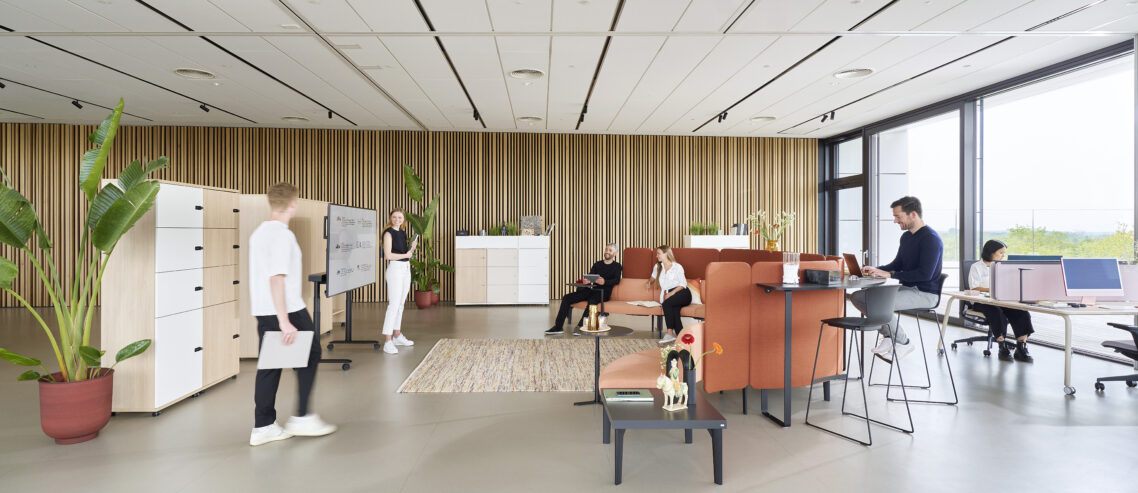Workplace strategy – interview with Hannah Nardini
In front of and behind the scenes – designing new working environments and workplace strategies is about understanding the big picture. The focus is on the workers themselves and their daily tasks. Hannah Nardini from WKspace in the UK is a consultant and has all this in mind. In this interview, she gives an insight into her work, developments and trends.
1. How would you describe Workplace Strategy to someone who has not heard of it yet?
Workplace strategy is an immersive experience within a business. The aim is to thoroughly understand the current business and identify operational and employee needs so that a comprehensive strategy can be created for their workplace. This strategy aims to improve productivity, morale, wellness and culture but at the same time drive efficiencies and savings.
2. How does your approach differ from other Workplace Strategy consultants?
We have a strong emphasis on occupational and behavioural psychology. This understanding of people allows our strategy to be practical and highly effective. A particular area of focus is multi-generational working and personality types in the workplace. This understanding, along with 26 years’ experience enables us to gather data quickly and accurately compared to many other consultants.
3. You have been working as a workplace consultant for 26 years. How has your work changed over the years?
There has been a shift away from purely cost driven decisions towards people more notably over the past 6 years. Finally, employers are seeing the importance of taking care of their people at a physical and psychological level as a means of naturally improving performance and retention of talent. Let’s not also forget the pandemic. We have seen the biggest shift in ways of working for a generation, and the most progressive businesses are now looking at how to permanently pivot the way they work and align the workplace to meet this.
4. Your consulting is based on detailed data analysis. Where do you obtain your data from? How can data help to adapt a company’s working patterns to the working environment to enable peak performance and reduce costs?
We obtain data from many sources. Since March 2020 we have been running regular global surveys on paid platforms to understand the current trends and thinking amongst employers and employees. In addition to this, we have worked with nearly 200 clients across 235 cities around the world. Data helps clients make informed decisions. When data is gathered and benchmarked against other similar organisations, it is possible to check if the information is reliable or an outlier. Clients are seeking reassurance and data allows us to provide that before they move in a new direction particularly relating to work styles or downsize of space.
5. The way of working has changed – and not only since the Corona pandemic. What do you think are the biggest challenges that companies face in terms of work and the work environment today?
While remote working has been highly successful for many businesses, it has also had its downsides. For example, people are spending extended times working and in front of a screen, communication across teams has slowed and some employers report quality and professional development is starting to suffer as a result of dispersed working. It is important for an employer to understand what the purpose of the office is in a post pandemic workplace and redesign the space to meet these needs. It is highly unlikely to be an office filled with desks but more around social spaces, collaboration and meeting zones.
6. You work with many well-known companies; can you share a recent example of how you partnered with a business to bring about fundamental change within their organisation?
We have been working with a global consultancy firm employing 30,000 people and our role is to build a new global working strategy, design standards and work style policies. This approach is then being rolled out to all 200 offices within their portfolio. The results so far have seen a reduction in real estate by over 30%, adoption of hybrid working practices, adoption of activity-based working within offices built around local needs and purpose and a standardisation in the style and branding of all workplaces globally. The recent engagement surveys have shown that performance has improved and satisfaction with the workplace and business is at an all-time high.
Expert talk at Clerkenwell Design Week
Join Sedus UK at Clerkenwell Design Week as we welcome guest speaker Hannah Nardini from WKspace to our showroom on Wednesday 25 and Thursday 26 May. Hannah will discuss with us different workplace scenarios, such as how equality, diversity and inclusion should become an organisational priority.
About Hannah Nardini

Hannah Nardini is one of the UK’s leading workplace strategists applying her 26 years of experience in the design of office interiors and the workplace.
Starting her career in Interior Design she went on to study Psychology paying focus to how people interact with each other and the environment they are within and understanding how this affects outcomes. Hannah has a unique and holistic approach to workplace solutions. Her focus is creating a great and practical work environment that inspires occupants to perform at their best. Along the way she will help customers to increase productivity and happiness levels, reduce real estate portfolios, build a positive workplace culture, reduce attrition rates and attract the new, yet elusive generation of workers. WKspace now offers a joined-up consultancy process for clients on a global platform which means Hannah regularly undertakes public speaking and conference engagements worldwide on a wide range of workplace, wellbeing and office design issues.
Also interesting:
- Building a thriving culture in the new work landscape
- Creative feel-good atmosphere – and the office becomes cosy
- New opening of the Sedus showroom in Madrid
- These are the interior trends for 2024
- How is Smart Thinking changing our working world?
